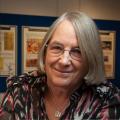WALLINGFORD is very fortunate to have three large open spaces to enjoy within the Conservation Area of its 9th century defences.
The impressive site of the demolished royal castle is one; the Kinecroft, used for centuries as a field for cows (one per burgess), is the second. The third is the Bullcroft, which has a more complicated tale to tell.
In Saxon times, the Parish Church of Holy Trinity stood in the south-west part of the present Bullcroft.
By 1085 it had been taken over by the great abbey of St Albans and became part of a new Priory.
According to records from the time, Abbot Paul ‘sent monks there and constructed buildings’.
The Priory was endowed with many lands, including several properties in Wallingford, which brought in money from rents.
The Church of Holy Trinity now served both parish and priory and priests were also supplied for three other Wallingford churches: St Martin’s (where Waitrose now stands), St John Super Aquam (once in Thames Street) and St Mary the More, still in the Market Place.
Evidence for the Priory comes from numerous documents and from archaeological investigations, especially a geophysical survey which helped to locate it.
The details have informed June Strong’s artist’s impression, but exciting new surveys are about to happen – look out for TWHAS members at work in the Bullcroft in mid November!
In 1525 the Pope permitted Cardinal Wolsey to close the Priory and use its income to help fund his new Oxford institution, ‘Cardinal’s College’, now called Christ Church.
The Priory buildings were pulled down and the stones sold: 120 cartloads went to repair Wallingford Bridge and many other carved remnants have since been discovered in foundations of walls and buildings in and near the Bullcroft.
The outer precincts of the Priory had a working farm – archaeology has revealed the ‘ridge and furrow’ strips of a medieval cultivated field at the north end of the Bullcroft.
The farm continued in use after the demolition – there was a house, a large barn and a big pond which appear on later maps.
By the outbreak of the First World War in 1914 the land was in possession of the wealthy Mr R.C.L. Powys Lybbe, who generously donated the whole Bullcroft to the town.
When the new gates were built, the disturbance of burials from the old church cemetery were a potent reminder of the past.
By the 1920s the Bullcroft was laid out for public use as a park, with a football pitch at the north end, a cricket pitch, bowling greens, tennis courts, plus swings and see-saws.
A wooden pavilion was built in 1937. Happily, many of these facilities continue today, together with a pre-school and Citizens Advice Bureau housed in the building near the entrance.
And the name ‘Bull Croft’? In medieval times it was ‘Bodecroft’, but by the 18th century it had evolved to its present title.
Even in the 1920s and 30s there were still cattle and sheep grazing amongst the recreational users – as there also were in the ‘Kine’ (cattle) croft nearby.









Comments: Our rules
We want our comments to be a lively and valuable part of our community - a place where readers can debate and engage with the most important local issues. The ability to comment on our stories is a privilege, not a right, however, and that privilege may be withdrawn if it is abused or misused.
Please report any comments that break our rules.
Read the rules hereLast Updated:
Report this comment Cancel